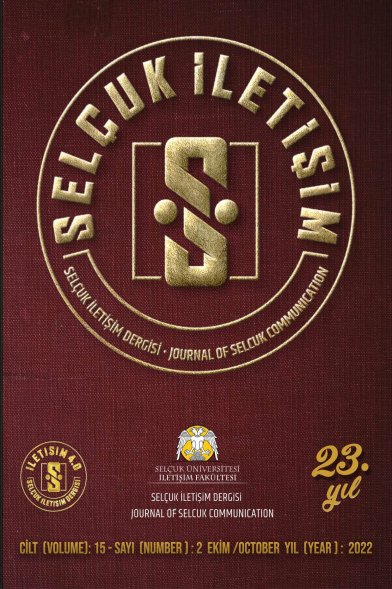Netflix Dizisi Hollywood'un Yapısökümcü Analizi
Jacques Derrida tarafından öne sürülen “yapısöküm”, yapısal hegemonileri, dildeki hiyerarşileri ortaya çıkarmak ve logos adı verilen dilin anlamındaki değişiklikleri ve istikrarsızlıkları bulmak için edebiyat ve felsefeyi birleştiren bir teoridir. Netflix mini dizisi Hollywood (2020) Ryan Murphy ve Ian Brennan tarafından yazılmış ve yönetilmiştir. Dizi, siyah ve beyaz ırklar arasındaki tahakküm uygulayıcı rolünün kişilerce el değiştirişini, anlamdaki tutarsızlıkları ve değişiklikleri, oyunları, cinsel kimlik karmaşalarını, ikili hegemonya çatışmasında önceden baskı altında olanlar yerine yeni hiyerarşilerin kurulmasını anlattığı için yapısöküm analizi için uygundur. Yapısöküm tekniği film eleştirisinde farklı şekillerde uygulanmıştır. Bu araştırmanın vaka çalışması; 1940'larda Hollywood'daki cinsiyetçi ve ırkçı ayrımcılığı işleyen bir yapım olan Hollywood dizisinin, mevcut tabularla savaşırken bilinçsizce yeni hiyerarşiler ve hegemonyalar inşa ettiğini gösterecektir. Bu çalışmanın amacı, film eleştirisinde daha önce yapılmış yapısöküm tekniklerine katkı sağlamaktır. Bu çalışmanın sonucu olarak, Hollywood dizisinin eleştirdiği tahakkümleri beslediği ve bu yapılara hizmet ettiği ortaya çıkmıştır.
Deconstructive Analysis of Netflix Series Hollywood
Deconstruction, put forward by Jacques Derrida, is a theory that combines literature and philosophy to reveal the structural hegemonies, hierarchies in the language, and to find alterations and instabilities in the language called “logos”. The Netflix miniseries Hollywood (2020) is created and produced by Ryan Murphy and Ian Brennan. It is suitable for deconstructive analysis, as it tells about a permanent displacement, inconsistencies, changes and plays in meaning, gender confusions and the establishment of new hierarchies instead of the fallen ones. Deconstruction technique has been conducted on film criticism in various ways. Case study of this research; the Hollywood series, which has claimed itself to have been a production against sexist and racist discrimination in the 1940s Hollywood, will be shown to have unconsciously constructed new hierarchies and hegemonies while fighting the existing taboos. The aim of this study is to contribute former practices of the use of deconstruction in film criticism. As a result of this study, it has been revealed that Netflix series Hollywood feeds the hegemonies it criticizes and serves those structures.
Keywords:
Deconstruction, Hollywood, Hegemony, Race, Gender,
___
- Barthes, R. (1978). Image music text. New York: Hill and Wang.
- Bennington, G. (1989). Deconstruction is not what you think. Omnibus Volume.
- Booth, D. (2006). Evidence revisited: Interpreting historical materials in sport history, rethinking history. The Journal of Theory and Practice, 459-483.
- Brunette, P. (1986). Toward a deconstructive theory of film. Studies in the literary imagination, 19 (1), 55.
- Derrida, J. (1979). "Living on" deconstruction and criticism. (H. Bloom, & J. Hulber, Trans.)
- Derrida, J. (1990). Some statements and truisms about neologisms, newisms, postisms, parasitisms, and other small seismisms. The states of theory, 63-94.
- Derrida, J. (1994). Specters of marx: the state of the debt, the work of mourning, and the new international . London: Routledge.
- Harvey, D. (1990). The condition of postmodernity. Oxford: Basil Blackwell.
- Hayward, S. (2006). Cinema studies the key concepts. Routledge.
- Jameson, F. (1991). Postmodernism or the cultural logic of late capitalism. London: Verso.
- McErlean, K. (2018). Interactive narratives and transmedia storytelling: Creating immersive stories across new media platforms. . Taylor & Francis.
- Norris, C. (2006). Deconstruction. London: Routledge.
- Rajyavardhan , K., & Sharma, S. (2017). Deconstruction as a method of film criticism.
- Ritzer , G., & Stepnisky, J. (2017). Modern sociological theory. Sage publications.
- Royle, N. (2000). What is deconstruction? In N. Royle, Deconstructions. London: Palgrave.
- Smith, R. (2000). Deconstruction and film. In N. Royle, Deconstructions (pp. 119-136). London: Palgrave.
- Spivak, G. C. (1976). Translator’s preface to of grammatology, by Jacques Derrida. MD: Johns Hopkins University Press.
- Vandenberg, P. (1995). Deconstruction. English Journal, , 84(2), 122.
- Yayın Aralığı: Yılda 2 Sayı
- Başlangıç: 1999
- Yayıncı: Selçuk Üniversitesi İletişim Fakültesi
Sayıdaki Diğer Makaleler
Tüketim Karşıtı Bireylerin Çevreci Reklamlara Olan Tutumları
Uyumlu Tasarıma Geçişte Kitle İletişim Araçlarının Gelişimi
“Nitelikli Televizyon”: Netflix Platformunda “Nitelikli Drama”nın Yeniden İnşası
Sosyal Medyada Nesneleştirme Aracılığıyla Mahremiyetin Reddi: Youtuberlar Üzerine Bir Değerlendirme
Mağduriyetin Sineması: Yunan Yeni Dalgası Üzerine Bir İnceleme
Bir Yer, Bir Kadın, Bir Öykü: Meryem Filminde Toplumsal Cinsiyetin Kültürel İnşası
Blockchain ve Yapay Zeka Bağlamında Dijital Kimlikler
Gerçekliğin Katmanları Arasından Üçüncü Sinemaya Doğru: “Ben, Daniel Blake”
